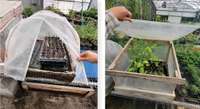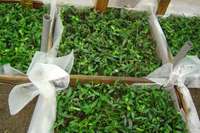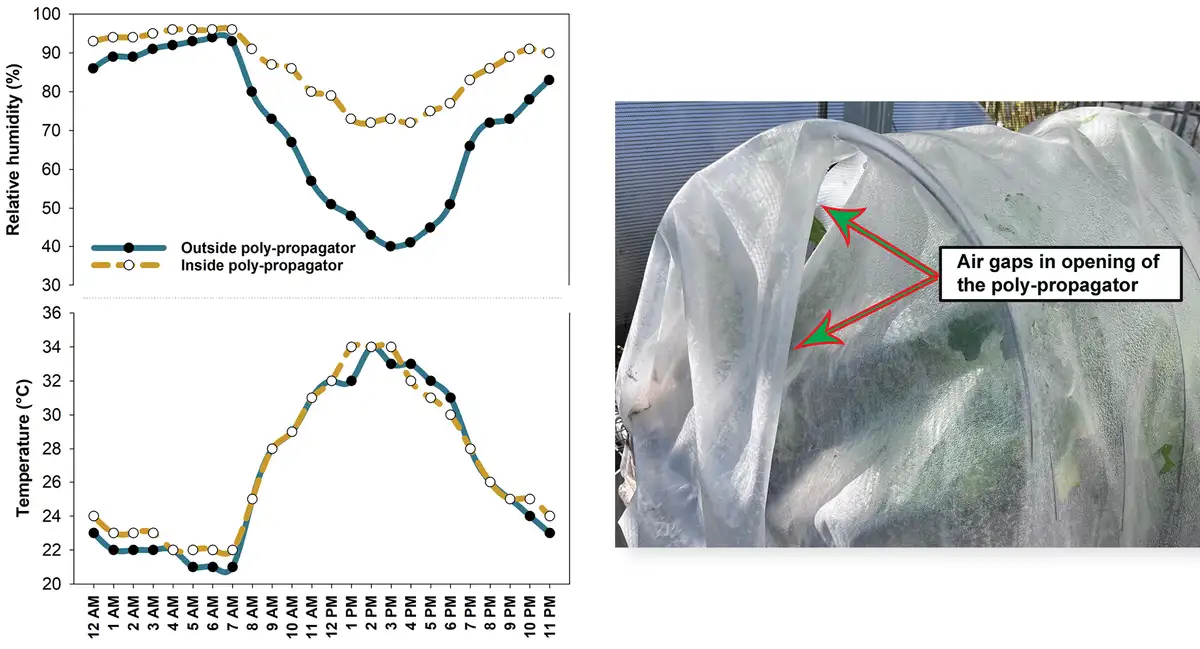Introduction

Figure 1. Two different poly-propagator frames used at ECHO North America. Source: Lauren Daniels Judge (left) and Lauren Kachel (right)
Poly-propagators are enclosures made of polyethylene (clear plastic) or plexiglass where you can grow plant material in a protected environment (Figure 1; Poly-propagator Video). These enclosed (or partially enclosed) structures increase humidity and resist temperature fluctuations for better success in propagating plants from cuttings and seeds. Poly-propagators stand out as a unique resource and appropriate technology for creating controlled environments in places where farmers have limited access to electricity, water, and supplies. This article discusses the purpose and use of poly-propagators for small-scale farmers and nursery owners. It also contains basic construction information.
Poly-propagators are seen globally from the UK to South America and were first introduced in research articles in the 1970s (Leakey et al., 1990). Poly-propagators are useful for farmers in need of a low-tech method for maintaining high humidity levels needed for optimal success in propagating many species of plants. The ability to create small spaces with high levels of humidity helps farmers in more arid regions and is also useful in greenhouses in places or during seasons with insufficient humidity.
Humidity control and consistent moisture are the two main benefits of poly-propagators. Poly-propagators provide constant humidity due to the enclosed construction and constant water supply. Air inside the poly-propagator maintains a high humidity level (75-95% humidity [Kebede et al., 2013; Mapongmetsem et al., 2016]) that significantly reduces the rate of transpiration for plants, decreasing the risk of desiccation. Water even condenses on the inside of the structure walls as the water holding-capacity of the air fluctuates.
Construction of a poly-propagator

Figure 2. Empty poly-propagators with metal wire hoops (left) and wood framing (right) at ECHO North America.
Source: Lauren Daniels Judge (left) and Lauren Kachel (right)
To construct a simple non-mist poly-propagator for propagating plant material, you will need:
- Wood frame (can also use metal, bamboo, or other locally available materials)
- Polyethylene sheet (clear or white; 6-8 mil preferred thickness) or plexiglass
- Nails, screws, or staples to join the polyethylene sheeting or plexiglass to the frame
Construct a frame that supports the polyethylene sheets or plexiglass on all sides, including a watertight base on the bottom (Figure 2). Depending on your planting approach, as explained later, the bottom holds standing water and/or planting media (e.g., sand, gravel, potting mix). The polyethylene or plexiglass on the bottom, sides, and top of the frame create a humidity chamber for the plant material. Leave one side with an opening through which you can access the plant material. To create an opening, fasten hinges on one side of the plexiglass frame or cut a slit through the polythene, allowing for easy clamping or unclamping of the plastic.

Figure 3. Media options for the base of the poly-propagator. Source: Stacy Swartz
Typically, the growing medium is layered, starting with sand as the first/bottom layer (a material that will not puncture the plastic), followed by gravel, and then additional potting media and/or sand as the top layer (Negash, 2021; Figure 3). One approach makes use of hollowed-out bamboo or PVC piping stuck into the sand base so you can soak the sand/gravel layer by adding water through the piping (Figure 4). With this watering method, water wicks1 through the medium up to the plant material. creating a “wicking bed” inside an enclosed chamber.

Figure 4. Poly-propagator with pipes inserted into the media at the bottom for watering. Source: Negash, 2021
Regardless of whether you use pipes for watering, add water at the base of the plants instead of from above with a hose or sprayer. While high humidity and low air circulation in poly-propagators are conducive to scale, fungus, and molds, watering from the bottom minimizes the risk of rotting by limiting leaf wetness and splashing of media onto plant material (which can spread disease). Remember, a primary advantage of a poly-propagator is consistent moisture through a constant water supply best achieved via upward wicking of water towards plant roots.
An alternative wicking design

Figure 5. Poly-propagator with cuttings set in germination trays. Source: Lauren Daniels Judge
An alternative design built at ECHO North America (Figure 5) uses germination trays with growing media, instead of sand and potting medium layers, with water wicking upwards into the trays from the reservoir. Insert a stand to allow the trays to sit just above the water level. You can use bricks, pieces of wood, or other material to elevate plants out of the water reservoir. Lighter material makes moving poly-propagators easier. Wicking of water to the plants will occur without having to submerge the trays in the water-filled basin below. With this design we get the benefit of high humidity in a small, enclosed space along with the convenience of using germination trays for semi-hardwood cuttings. The ECHO North America nursery uses these modified poly-propagators in the greenhouse instead of mist houses or other higher-tech options.
Uses of poly-propagators in nursery care
Poly-propagators are especially useful in the propagation of hardwood and semi-herbaceous cuttings. Herbaceous cuttings like longevity spinach (Gynura procumbens) or tropical oregano (Coleus amboinicus) do not show an increased success rate inside the poly-propagators from the experiences of ECHO North America staff. This is likely because of their lower humidity requirements compared to hardwood cuttings.
Not surprisingly, poly-propagators are mostly used for tree nurseries. At ECHO North America, passionfruit (Passiflora edulis), bay leaf (Laurus nobilis), barbados cherry (Malpighia emarginata), figs (Ficus carica), and katuk (Sauropus androgynus) are examples of plants showing greater success rates when asexually propagated (with woody stem cuttings) in poly-propagators.
Hints and tips
Depending on the season, allow more airflow into poly-propagators by lifting sides of the polythene or plexiglass. In the hottest months, we find that temperatures inside the poly-propagators can reach higher than 35°C (95°F), which is too hot for most propagation material. During hot months, check the humidity and heat levels in the poly-propagator daily and adjust the airflow accordingly.2 You can roll the polyethylene sides up so that you slowly wean the plants into lower humidity or provide temporary relief from heat.

Figure 6. Air temperature and humidity (top) within and outside a poly-propagator (bottom) in a greenhouse at ECHO in southwest Florida. Each data point is the average of two or more logger readings taken from 3 to 5 May 2024. Source: Tim Motis
Because of the high humidity and condensation in and around the poly-propagator, you may find fungal and bacterial growth a problem. When starting a new batch of cuttings, fully empty and clean out the poly-propagator. We sterilize our poly-propagators with a diluted vinegar or isopropyl alcohol spray in between usage. Remove all water and residues before introducing a new batch of plants into a poly-propagator.
Resources
How to build a poly-propagator:
Munjuga, M., D. Ofori, C. Sawe, E. Asaah, P. Anegbeh, T. Peprah, M. Mpanda, L. Mwaura, E. Mtui, C. Sirito, A. Atangana, S. Henneh, Z. Tchoundjeu, R. Jamnadass, and A.J. Simons. 2008. Allanblackia propagation protocol. World Agroforestry Center. ISBN 978-92-9059-231-0. http://edn.link/7y4rgf
An example of poly-propagator use:
Kouakou K. L., J.P Dao, K.I. Kouassi, M.M. Beugré, M. Koné, J.P. Baudoin, I.A. Zoro Bi. 2016. Propagation of Garcinia kola (Heckel) by stem and root cuttings. Silva Fennica. 50(4): 1588. http://edn.link/d23rwj
Information on the use of poly-propagators for general nursery management:
Jaenicke, H. 1999. Good Tree Nursery Practices: Practical Guidelines for Community Nurseries. International Centre for Research in Agroforestry. ISBN 92 9059 130. http://edn.link/p6td6w
References
Berkelaar, D. 2012. Wick Irrigation. ECHO Development Notes no. 115.
Kebede, M. H. Hulten, and G. Balcha, 2013. Vegetative Propagation of Juvenile Leafy Stem Cuttings of Prunus africana (Hook.f.) Kalkm and Syzygium guineense (Willd.) DC. International Journal of Botany, 9:30-36.
Leakey, R. R. B., J.F. Mesén,Z. Tchoundjeu,K.A. Longman, J. Mcp. Dick, A. Newton, A. Matin,J. Grace,R.C. Munro, and P.N. Muthoka. 1990. Low-technology Techniques for the Vegetative Propagation of Tropical Trees. The Commonwealth Forestry Review, 69(3):247–257. http://www.jstor.org/stable/43738151
Mapongmetsem, P. M., G. Fawa, J.B. Noubissie-Tchiagam, and B. Nkongmeneck. 2016. Vegetative propagation of Vitex doniana Sweet from root segments cuttings. https://agritrop.cirad.fr/580991/1/BFT_327_29-37.pdf
Negash, L. 2021. A Selection of African Native Trees: Biology, Uses, Propagation and Restoration Techniques. Addis Ababa University, Ethiopia.
Cite this article as:
Daniels-Judge, L. 2024. Poly-propagators. ECHO Development Notes no. 164.